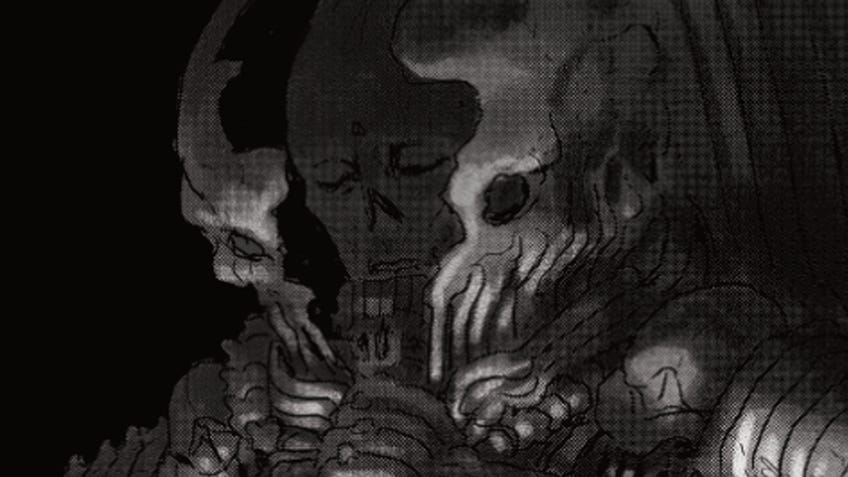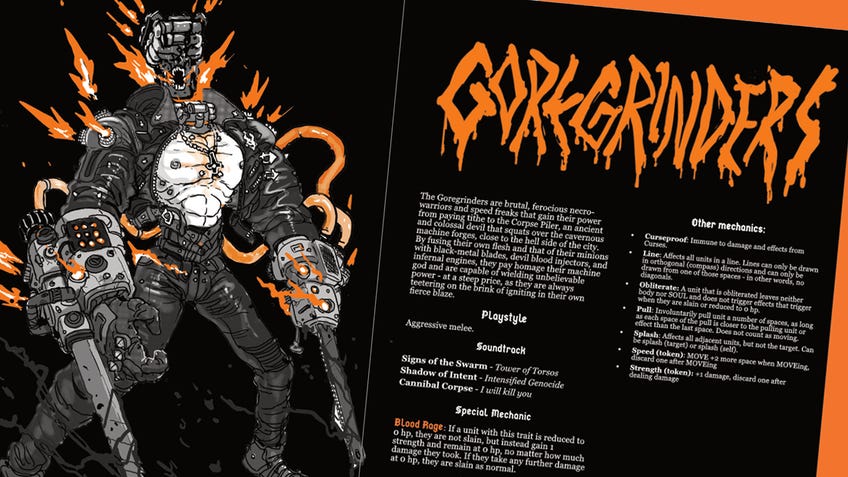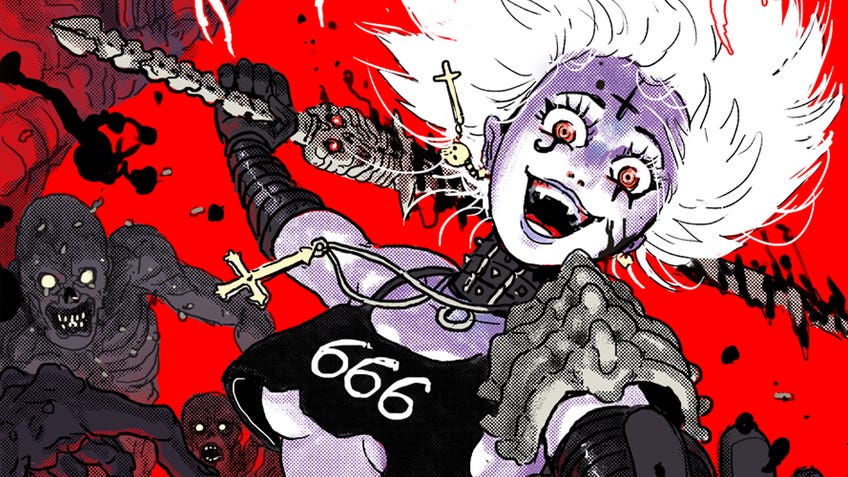Lancer creator’s Magnagothica: Maleghast melds Necromunda with Doom for a hell of a good time
Bloody beautiful.
Magnagothica: Maleghast is one of the year’s quieter releases. It’s an indie skirmish wargame, intended for virtual tabletops (no physical miniatures, but playable on Roll20, Tabletop Simulator and so on), and the whole thing is masterminded and illustrated by Tom Bloom, half of Massif Press - responsible for mech RPG Lancer - and all of webcomic Kill Six Billion Demons. It first caught my attention thanks to its creator’s significant pedigree and its commitment to a Hell-themed look. (The game released on Halloween and is sold for $6.66 on Itch.io.) But, after playing it, I’ve discovered that Maleghast is a brilliant little game that punches far above its weight class in terms of look, pace and sheer fun.
The first thing you’ll notice about Maleghast is its aesthetic. Granted, it’s hard to miss. Described influences are ‘heavy metal and gothic horror’, but this doesn’t quite do it justice. The game takes aesthetic notes from H.R. Giger, Doom, Necromunda and classic fantasy in equal parts, a wildly exuberant aesthetic tied together by Bloom’s artistic talent, experience and eye for action.
Bloom is an unabashed maximalist, his necromancers adorned with everything from unholy grimoires to cigarette packets. This aesthetic mastery is best put to work in Maleghast’s vibrant, distinct factions. CARCASS is a private military company adorned with calcified spec ops gear. The Goregrinders fuse Mad Max engines with slasher-flick hockey masks. The Deadsouls feed on classic Satanic Panic motifs of horned devils, inverted crucifixes and exorcist-inspired Banshees. This culminates in an overall feel that is in equal parts camp and creep, and sure to mesmerise before a single line of rules text is read.
Lucky for us, Maleghast’s gameplay delivers on its aesthetic promises. Everything is set up to ensure ease of play and relatively quick games; attacks can’t truly miss, for example. But most importantly, your skeletal squad has an ever-present kill switch - your necromancer themselves, whose death is an instant loss condition.
The overall feel is in equal parts camp and creep, and sure to mesmerise before a single line of rules text is read.
The game’s pace is set by its efforts to streamline play; buffs and debuffs are crystallised into the token system, an easy method of tracking that minimises time spent poring through oblique passive effects. A particular standout is that faction title pages contain their own mini-glossaries of all their relevant mechanics, reducing the need to parse the entire rulebook for a single ruling. As a result, the play experience has been smoothed out to the point of surprising ease - although in part thanks to Maleghast’s simplicity and youth, some more specific rulings can mire the pace, and may require home-ruling to patch up.

Although its units steal the show, Maleghast’s underlying systems do a lot of heavy lifting. It’s not immediately apparent through reading, but even a single game of Maleghast will call immediate attention to its maps. The default size is a chessboard-size eight-by-eight spaces for one-on-one play - but this all gets a whole lot smaller once walls, hazards, adverse terrain and units are thrown into the mix. Players don’t quite start within firing range of one another, but there’s scarcely any time at all to position before the action starts.
The claustrophobic maps complement Maleghast’s unique unit design; in cramped spaces, its two-by-two Tyrant units feel like hulking bulwarks that warp the map around them, difficult to manoeuvre but equally deadly. The terrain serves to highlight factional differences in ways of approaching the map; Gargamox’s small units and hazard immunity allow them to corner areas of the battlefield where other units dare not go, Deadsouls isolate enemy units with walls, CARCASS thrive in elevation and cover. Maleghast expects you to play the map just as much as you play your faction, and the cramped, dangerous streets of Anzenmezzeron are brought to life through your skirmishes.

The culmination of all this is that Maleghast offers a tantalising strategic ideal that players have to extricate from the game’s natural tendency towards glorious bloodbaths. Factional teams are usually built off synergies between units. For CARCASS, the trio of frontline Enforcers make space for damage-dealing Barrelforms supplied by Ammo Goblins.
The game’s most exciting moments come from the frantic and makeshift.
But Maleghast’s units are squishy as anything, and the low cap on the number of allocated units means that you can’t have backups of one type without cutting into your numbers of another. So when your Ammo Goblin is drawn out of position by an enemy Chosen, or your Enforcer is taken out by a lucky 6 roll from an enemy Carnifex, what then?
The first level of Maleghast is understanding the little synergies between your units; the setup and payoff that leads to tight play. The game’s most exciting moments then come from the frantic and makeshift - the scrambles to preserve these systems as your troops dwindle and the skirmishes descend into low-resource, back-alley scraps.

For all its diverse units, Maleghast’s necromancers are the backbone of every battle. A key part of this frantic stabilisation is SOUL, a resource gained over time, accelerated by the deaths of your fellow units, spent on powerful necromantic abilities. The effect on play is instant - it’s a catchup mechanic, keeping up the pace of play and allowing players to crawl back into games where they take early losses. Of course, it’s up to players how this comeback takes place. Some might opt for piecemeal advantage gained from abilities like the Operator’s Double Tap; others might prefer a blaze of glory, your Warlord taking out the enemy Chirurgeon at the eleventh hour through a stack of Vitality tokens with their 6 SOUL Devil Impact.
Maleghast is as fast as it is beautiful. Matches are wrapped up in six rounds either way, turns are quick, units are squishy. The low price point, digital focus and streamlined rulebook lead to an experience that is wonderfully up-tempo: quick to pick up, easy to play (matches often end in under an hour) and surprisingly addicting.
Maleghast may have been one of the year’s quieter releases, but as digital support continues to grow, it’s become one of 2023’s undeniable gems.

